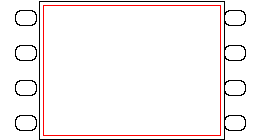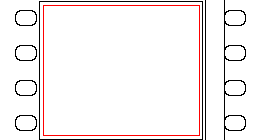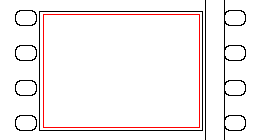

 |
 |
 |
 |
 |
 |
 |
 |
 |
 |
In order to understand how the current shooting formats came into use, it is beneficial to take a quick look at the evolution of the use of 35mm film over the past 100 years. Originally, 35mm film was used to store images with no sound. The entire area between the two sets of perforations was used for the image. This area had an aspect ratio of 1.33:1, which is exactly the same as a television set. The diagram below shows the image area.
 |
| Original 0.980" by 0.735" (black rectangle) camera aperture for silent film. |
When the capability to reproduce sound was added to film, an optical soundtrack was placed on the edge of the image area, sacrificing some of the width. This resulted in a more square aspect ratio of 1.17:1. The diagram below shows the reduced image area as a result of the addition of the soundtrack.
 |
| The 1.17:1 image area (black rectangle) with soundtrack area at right edge of image. |
Having the ability to record sound was nice, but the aspect ratio change that resulted from it was not so nice. The solution was to shrink the height of the image area so that the aspect ratio would be approximately the same as before the addition of the soundtrack. This new format became the standard for movies shot on 35mm film, and remained so until 1953. The diagram below shown the camera and projector apertures for this format, which is called Academy.
 |
| The academy format (1.37:1 aspect ratio) Camera aperture (black): 0.864" by 0.630" Projector aperture (red): 0.825" by 0.602". |
Up until the 1950s, things were pretty simple. The aspect ratio of the image recorded on the film by the camera was the aspect ratio that was used in theatres, and the image ratios were close enough to television's 1.33:1 ratio to not be a problem.
Along came the widescreen craze of the 1950s, which changed movie filming forever! The techniques in use today came along during the 1950s, when television began to hurt theatres. Something had to be done to get people back into theatres, and doing so required giving people something they could not get at home on their television set, and this was wider, larger images.
So, to get a wider image using the same old 35mm film, there are three basic approaches: